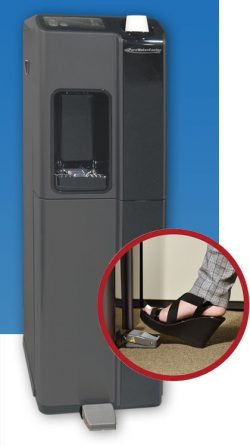What Are Total Dissolved Solids and Are They Safe to Drink?
Total dissolved solids (TDS) consist of organic and non-organic solids, and they impact your drinking water. In this guide, we’re going to explain the following:
- What are total dissolved solids?
- Are total dissolved solids safe to drink?
- TDS filtration methods for drinking water
What Are Total Dissolved Solids?
TDS is a measurement of the particles that are dissolved in a specific volume of water. Particles can include an array of materials:
- Ions
- Metals
- Salt
- Minerals
- Arsenic
- Lead
- Aluminum
- Calcium
- Potassium
- Herbicides
- Pesticides
- Sulfates
- Fluoride
- Many others
Total dissolved solids are the end result of particles that are absorbed into the water at a certain volume. For example, you can have TDS whether you have a well, natural spring, city water, or any other source of water.
Due to the nature of TDS, you may have organic and non-organic materials in your water.
While magnesium and potassium may not be a major concern in your drinking water, pesticides, and herbicides can also filter into the ground and enter water sources. TDS can also be a good thing, as seen in many grocery stores.
If you’ve ever seen bottled mineral water in the store, you can be confident that the manufacturer “infused” the water with natural minerals.
Are Total Dissolved Solids Safe to Drink?
Yes and no. Organic materials, up to a certain level, may be safe to drink. However, if your water is found to have any of the following, it may be unsafe to drink:
- Arsenic
- Copper
- Lead
Low levels of lead may not cause serious health issues, but high levels can cause you to suffer nervous system damage. Obviously, even a small number of pesticides in your water is a major health concern.
In general, low TDS levels are a sign of a good water source.
High TDS levels of 500ppm or higher is a sign that it’s time to get your water checked. The high ppm can be a cause for concern if the particles are toxic. If you have 1000ppm or higher, the water is unsafe for human consumption.
Different particles are more concerning than others in your water.
Drinking water that is filled with pesticides or lead at 500ppm is a significant health concern and something that needs to be addressed promptly. However, if the particles are primarily natural, your water may still be safe to drink.
If your water is found to contain a high level of calcium and certain other particles, this may be a warning sign for your plumbing system. These particles can build up inside of your pipes, causing them to need premature replacement.
Appliance lifespans can also be shortened due to the buildup of these particles. TDS measurements can be performed to better understand what particles are in your drinking water.
Particles may be safe or unsafe, depending on what they are.
Some people even state that the TDS in their water impacted the taste of their food.
You can:
- Test your water using an at-home water test kit
- Hire a lab to analyze your water for TDS
Lab testing is a good option if an at-home kit shows that there’s a high amount of TDS in your water and you want to ensure that the water source is safe to drink from.
Water filtration is one of the key ways to ensure that your water isn’t filled with harmful total dissolved solids. The following is a list of filtration methods that you can use to lower or eliminate TDS in your water.
TDS Filtration Methods for Drinking Water
Can you lower TDS by filtration? Yes! Filtration systems can help reduce or even remove TDS from water. While there are several types of filtration systems, some of the most comprehensive options are reverse osmosis, water distillation and deionization.
Reverse Osmosis
Reverse osmosis is a multi-stage filtration system, and it’s one of the most comprehensive filtration systems available.
Reverse osmosis uses pressure to push water through a semi-permeable membrane. This process removes contaminants from the water rather than collecting them in a filter media (like with standard filtration).
The water continues to be pushed through a series of filters, and the remaining clean water gets moved into a holding tank. All contaminants are then flushed down the drain.
The complex reverse osmosis filtration system can remove a number of contaminants, some of which can’t be removed through standard filtration, including:
- Fluoride
- Lead
- Pesticides
- Chlorine
- Chloramine
- Nitrates and sulfates
- Detergents
- Much more
Reverse osmosis is a popular way to remove or reduce TDS in water because it’s so effective.
Water Distillation
Water distillation is another filtration process that can reduce TDS in water. The process is a simple and straightforward one:
- Water is heated to a rolling boil until it evaporates into steam.
- The steam is captured and condensed.
- The clean water is moved into a clean container.
Most of the non-volatile and inorganic compounds in the water won’t be able to evaporate with the water. These compounds get left behind in the boiling chamber.
The process produces clean and pure water, and can be used to remove:
- Heavy metals
- Bacteria
- Chemicals
Some contaminants may have a lower boiling point than water and may re-contaminate the water. For this reason, many distillers use a filter media (like activated carbon) to remove any remaining contaminants before the water leaves the unit.
Water distillation is not a quick process. It can take up to 6 hours to distill a single gallon of water.
Deionization
Water deionization, or demineralization, is another filtration process that works by removing ions from the water. Ions are molecules or atoms that are electrically charged and have either a positive charge (called Cations) or negative charge (called Anions).
The process can remove salts, minerals, and contaminants.
Deionization works by using resins. Cation resins have a negative functional group, so they attract positively-charged ions. Anion resins have a positive functional group, so they attract negatively-charged ions.
Cations (positively-charged ions) include:
- Manganese
- Calcium
- Sodium
- Iron
- Hydrogen
Anions (negatively-charged ions) include:
- Sulfates
- Nitrates
- Chlorides
- Silica
- Carbonates
- Hydroxyl
To remove or reduce TDS through deionization, water is pushed through positive and negative electrodes.
Final Thoughts
If you’re concerned about the TDS levels in your water, filtration can help. Using a total dissolved solids procedure, like the ones listed above, can help ensure that you’re drinking clean, pure water.
To learn more about total dissolved solids or other impurities in your water and to find out which water filtration and purification process is best for your drinking water, contact Cool Planet Water today.




